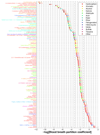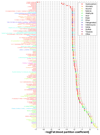Assessment of the exhalation kinetics of volatile cancer biomarkers based on their physicochemical properties
- PMID: 24566039
- PMCID: PMC4966621
- DOI: 10.1088/1752-7155/8/1/016003
Assessment of the exhalation kinetics of volatile cancer biomarkers based on their physicochemical properties
Abstract
The current review provides an assessment of the exhalation kinetics of volatile organic compounds (VOCs) that have been linked with cancer. Towards this end, we evaluate various physicochemical properties, such as 'breath:air' and 'blood:fat' partition coefficients, of 112 VOCs that have been suggested over the past decade as potential markers of cancer. With these data, we show that the cancer VOC concentrations in the blood and in the fat span over 12 and 8 orders of magnitude, respectively, in order to provide a specific counterpart concentration in the exhaled breath (e.g., 1 ppb). This finding suggests that these 112 different compounds have different storage compartments in the body and that their exhalation kinetics depends on one or a combination of the following factors: (i) the VOC concentrations in different parts of the body; (ii) the VOC synthesis and metabolism rates; (iii) the partition coefficients between tissue(s), blood and air; and (iv) the VOCs' diffusion constants. Based on this analysis, we discuss how this knowledge allows modeling and simulating the behavior of a specific VOC under different sampling protocols (with and without exertion of effort). We end this review by a brief discussion on the potential role of these scenarios in screening and therapeutic monitoring of cancer.
Figures



References
-
- Sponring A, Filipiak W, Mikoviny T, Ager C, Schubert J, Miekisch W, Amann A, Troppmair J. Release of volatile organic compounds from the lung cancer cell line NCI-H2087 in vitro. Anticancer Res. 2009;29:419–26. - PubMed
-
- Sponring A, Filipiak W, Ager C, Schubert J, Miekisch W, Amann A, Troppmair J. Analysis of volatile organic compounds (VOCs) in the headspace of NCI-H1666 lung cancer cells. Cancer Biomarkers A. 2010;7:153–61. - PubMed
Publication types
MeSH terms
Substances
Grants and funding
LinkOut - more resources
Full Text Sources
Other Literature Sources
Miscellaneous
